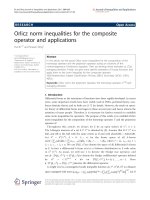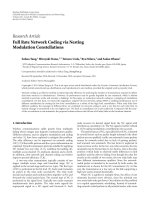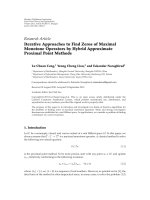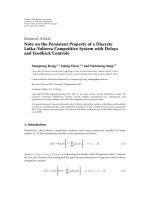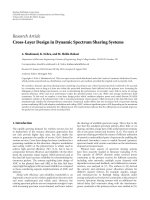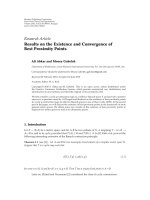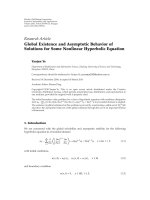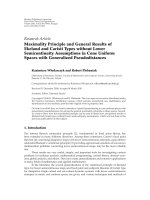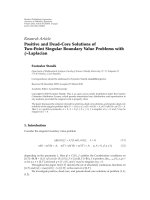Báo cáo hóa học: " Research Article Inequalities for the Polar Derivative of a Polynomial" pot
Bạn đang xem bản rút gọn của tài liệu. Xem và tải ngay bản đầy đủ của tài liệu tại đây (481.08 KB, 9 trang )
Hindawi Publishing Corporation
Journal of Inequalities and Applications
Volume 2009, Article ID 515709, 9 pages
doi:10.1155/2009/515709
Research Article
Inequalities for the Polar Derivative of
a Polynomial
M. Bidkham, M. Shakeri, and M. Eshaghi Gordji
Department of Mathematics, Faculty of Natural Sciences, Semnan University,
Semnan 35195-363, Iran
Correspondence should be addressed to M. Bidkham,
Received 11 August 2009; Accepted 30 November 2009
Recommended by Narendra Kumar Govil
Let pz be a polynomial of degree n and for any real or complex number α,andletD
α
pz
npzα − zp
z denote the polar derivative of the polynomial pz with respect to α.In
this paper, we obtain new results concerning the maximum modulus of a polar derivative of a
polynomial with restricted zeros. Our results generalize as well as improve upon some well-known
polynomial inequalities.
Copyright q 2009 M. Bidkham et al. This is an open access article distributed under the Creative
Commons Attribution License, which permits unrestricted use, distribution, and reproduction in
any medium, provided the original work is properly cited.
1. Introduction and Statement of Results
If pz is a polynomial of degree n, then it is well known that
max
|z|1
p
z
≤ n max
|z|1
p
z
.
1.1
The above inequality, which is an immediate consequence of Bernstein’s inequality applied
to the derivative of a trigonometric polynomial, is best possible with equality holding if and
only if pz has all its zeros at the origin. If pz
/
0in|z| < 1, then
max
|z|1
p
z
≤
n
2
max
|z|1
p
z
.
1.2
Inequality 1.2 was conjectured by Erd
¨
os and later proved by Lax 1. If the polynomial pz
of degree n has all its zeros in |z| < 1, then it was proved by Tur
´
an 2 that
2 Journal of Inequalities and Applications
max
|z|1
p
z
≥
n
2
max
|z|1
p
z
.
1.3
Inequality 1.2 was generalized by Malik 3 who proved that if pz
/
0in|z| <k,k≥ 1,
then
max
|z|1
p
z
≤
n
1 k
max
|z|1
p
z
.
1.4
For the class of polynomials having all its zeros in |z|≤k, k ≥ 1, Govil 4 proved that
max
|z|1
p
z
≥
n
1 k
n
max
|z|1
p
z
.
1.5
Inequality 1.5 is sharp and equality holds for pzz
n
k
n
. By considering a more general
class of polynomials pza
0
n
νt
a
ν
z
ν
, 1 ≤ t ≤ n, not vanishing in |z| <k, k ≥ 1, Gardner
et al. 5 proved that
max
|z|1
p
z
≤
n
1 s
0
max
|z|1
p
z
− m
, 1.6
where m min
|z|k
|pz| and s
0
k
t1
{t/n|a
t
|/|a
0
|−mk
t−1
1/t/n|a
t
|/|a
0
|−
mk
t1
1}.
Let D
α
{pz} denote the polar derivative of the polynomial pz of degree n with
respect to the point α. Then
D
α
p
z
np
z
α − z
p
z
. 1.7
The polynomial D
α
{pz} is of degree at most n − 1 and it generalizes the ordinary derivative
in the sense that
lim
α →∞
D
α
p
z
α
p
z
. 1.8
As an extension of 1.5, it was shown by Aziz and Rather 6 that if pz has all its zeros in
|z|≤k, k ≥ 1, then for |α|≥k,
max
|z|1
D
α
p
z
≥ n
|
α
|
− k
1 k
n
max
|z|1
p
z
.
1.9
Inequality 1.9 was later sharpened by Dewan and Upadhye 7, who proved the following
theorem.
Journal of Inequalities and Applications 3
Theorem A. Let pz be a polynomial of degree n having all its zeros in |z|≤k, k ≥ 1, then for
|α|≥k,
max
|z|1
D
α
p
z
≥ n
|
α
|
− k
1
1 k
n
max
|z|1
p
z
1
2k
n
k
n
− 1
k
n
1
m
,
1.10
where m min
|z|k
|pz|.
Recently, Dewan et al. 8 extented inequality 1.6 to the polar derivative of a
polynomial and obtained the following result.
Theorem B. If pza
0
n
νt
a
ν
z
ν
, 1 ≤ t ≤ n, is a polynomial of degree n having no zeros in
|z| <k, k≥ 1, then for |α|≥1,
max
|z|1
D
α
p
z
≤
n
1 s
0
|
α
|
s
0
max
|z|1
p
z
−
|
α
|
− 1
m
,
1.11
where m min
|z|k
|pz| and s
0
k
t1
{t/n|a
t
|/|a
0
|−mk
t−1
1/t/n|a
t
|/|a
0
|−
mk
t1
1}.
In this paper, we will first generalize Theorem A as well as improve upon the bound
obtained in inequality 1.10 by involving some of the coefficients of pz. More precisely, we
prove the following.
Theorem 1.1. If pz
n
i0
a
i
z
i
is a polynomial of degree n ≥ 3 having all its zeros in |z|≤k, k ≥
1, then for |α|≥k,
max
|z|1
D
α
p
z
≥ n
|
α
|
− k
1
k
n
1
max
|z|1
p
z
k
n
− 1
2k
n
k
n
1
m
2
|
a
n−1
|
k
k
n
1
n 1
k
n
− 1
n
−
k − 1
2
|
a
n−2
|
k
n
1
k
2
k
n
− 1
− n
k − 1
n
n − 1
−
k
n−2
− 1
−
n − 2
k − 1
n − 2
n − 3
1
k
n−1
k
n−1
− 1
n − 1
−
k
n−3
− 1
n − 3
|
n − 1
a
1
2αa
2
|
2
k
n−1
k
n−1
− 1
n 1
|
na
0
αa
1
|
n
|
α
|
k
2k
n
m
1.12
4 Journal of Inequalities and Applications
for n>3 and
max
|z|1
D
α
p
z
≥ n
|
α
|
− k
1
k
n
1
max
|z|1
p
z
k
n
− 1
2k
3
k
n
1
m
2
|
a
n−1
|
k
k
n
1
n 1
k
n
− 1
n
−
k − 1
2k
n−5
|
a
n−2
|
k
n
1
k − 1
n
n
n − 1
k − 1
2k
2
k 1
|
na
0
αa
1
|
k − 1
|
n − 1
a
1
2αa
2
|
n
|
α
|
k
2k
3
m
1.13
for n 3,wherem min
|z|k
|pz|.
Now it is easy to verify that if k ≥ 1, then k
n
−1/n−k−1 ≥ 0, k
n−1
−1/n−1−k
n−3
−
1/n−3 ≥ 0andk
n
−1−nk−1/nn−1−k
n−2
−1−n−2k−1/n−2n−3 ≥ 0
for n>3. Hence for polynomial of degree n ≥ 3, Theorem 1.1 is a refinement of Theorem A.
Dividing both sides of inequalities 1.12 and 1.13 by |α| and letting |α|→∞,weget
the following result.
Corollary 1.2. If pz
n
i0
a
i
z
i
is a polynomial of degree n ≥ 3 having all its zeros in |z|≤k,
k ≥ 1,then
max
|z|1
p
z
≥
n
k
n
1
max
|z|1
p
z
m
2
k
n 1
k
n
− 1
n
−
k − 1
|
a
n−1
|
2
k
2
k
n
− 1
− n
k − 1
n
n − 1
−
k
n−2
− 1
−
n − 2
k − 1
n − 2
n − 3
|
a
n−2
|
×
2
k
n−1
− 1
k
n−1
n 1
|
a
1
|
2
k
n−1
k
n−1
− 1
n − 1
−
k
n−3
− 1
n − 3
|
a
2
|
1.14
for n>3 and
max
|z|1
p
z
≥
n
k
n
1
max
|z|1
p
z
m
2
k
n 1
k
n
− 1
n
−
k − 1
|
a
n−1
|
2
k
2
k − 1
n
n
n − 1
|
a
n−2
|
k − 1
2k
2
k 1
|
a
1
|
2
k − 1
|
a
2
|
1.15
for n 3,wherem min
|z|k
|pz|.
These inequalities are sharp and equality holds for the polynomial pzz
n
k
n
.
Journal of Inequalities and Applications 5
If we take k 1 in the previous Theorem, we get a result, which was proved by Aziz
and Dawood 9.
Next we consider a class of polynomial having no zeros in |z| <k, where k ≥ 1and
prove the following generalization of Theorem B.
Theorem 1.3. If pza
0
n
νμ
a
ν
z
ν
, 1 ≤ μ ≤ n, is a polynomial of degree n having no zeros in
|z| <k, k≥ 1, then for 0 <r≤ R ≤ k and |α|≥R,
max
|z|R
D
α
p
z
≤
n
1 s
0
|
α
|
R
s
0
exp
n
R
r
A
t
dt
max
|z|r
p
z
s
0
1 −
|
α
|
R
s
0
exp
n
R
r
A
t
dt
m
,
1.16
where
A
t
μ/n
a
μ
/
|
a
0
|
− m
k
μ1
t
μ−1
t
μ
t
μ1
k
μ1
μ/n
a
μ
/
|
a
0
|
− m
k
μ1
t
μ
k
2μ
t
,
s
0
k
R
μ1
μ/n
a
μ
Rk
μ−1
/
|
a
0
|
− m
1
μ/n
a
μ
k
μ1
/
|
a
o
|
− m
R
1
,
m min
|z|k
p
z
.
1.17
Remark 1.4. For R r 1 Theorem 1.3 reduces to Theorem B.
Remark 1.5. Dividing the two sides of 1.16 by |α| and letting |α|→∞, we obtain a result of
Chanam and Dewan 10.
2. Lemmas
For the proofs of these theorems we need the following lemmas.
Lemma 2.1. If pz has all its zeros in |z|≤1, then for every |α|≥1,
max
|z|1
D
α
p
z
≥
n
2
|
α
|
− 1
max
|z|1
p
z
|
α
|
1
m
,
2.1
where m min
|z|1
|pz|.
This lemma is due to Aziz and Rather 6 .
6 Journal of Inequalities and Applications
Lemma 2.2. If pz is a polynomial of degree n, having all its zeros in |z|≤k,wherek ≥ 1,then
max
|z|k
p
z
≥
2k
n
1 k
n
max
|z|1
p
z
.
2.2
Inequality 2.2 is best possible and equality holds for pzz
n
k
n
.
This lemma is according to Aziz 11.
Lemma 2.3. If pz is a polynomial of degree n, then for R ≥ 1,
max
|z|R
p
z
≤ R
n
max
|z|1
p
z
−
2
R
n
− 1
n 2
p
0
−
R
n
− 1
n
−
R
n−2
− 1
n − 2
p
0
2.3
if n>2, and
max
|z|R
p
z
≤ R
2
max
|z|1
p
z
−
R − 1
2
R 1
p
0
R − 1
p
0
2.4
if n 2.
This lemma is according to Dewan et al. 12.
Lemma 2.4. If pz is a polynomial of degree n ≥ 3 having no zeros in |z| < 1 and m min
|z|1
|pz|,
then for R ≥ 1,
max
|z|R
p
z
≤
R
n
1
2
max
|z|1
p
z
−
R
n
− 1
2
m −
p
0
2
n 1
R
n
− 1
n
−
R − 1
−
p
0
R
n
− 1
− n
R − 1
n
n − 1
−
R
n−2
− 1
−
n − 2
R − 1
n − 2
n − 3
2.5
if n>3, and
max
|z|R
p
z
≤
R
n
1
2
max
|z|1
p
z
−
R
n
− 1
2
m
−
p
0
2
n 1
R
n
− 1
n
−
R − 1
−
p
0
R − 1
n
n
n − 1
2.6
if n 3.
This result is according to Dewan et al. 13.
Journal of Inequalities and Applications 7
Lemma 2.5. If pza
0
n
νμ
a
ν
z
ν
, 1 ≤ μ ≤ n is a polynomial of degree n such that pz
/
0 in
|z| <k, k>0, then for 0 <r≤ R ≤ k,
max
|z|R
p
z
≤ exp
n
R
r
μ/n
a
μ
/
|
a
0
|
− m
k
μ1
t
μ−1
t
μ
t
μ1
k
μ1
μ/n
a
μ
/
|
a
0
|
− m
k
μ1
t
μ
k
2μ
t
dt
max
|z|r
p
z
1 − exp
n
R
r
μ/n
a
μ
/
|
a
0
|
− m
k
μ1
t
μ−1
t
μ
t
μ1
k
μ1
μ/n
a
μ
/
|
a
0
|
− m
k
μ1
t
μ
k
2μ
t
dt
m,
2.7
where m min
|z|k
|pz|.
Lemma 2.5 is according to Chanam and Dewan 10.
3. Proof of the Theorems
Proof of Theorem 1.1. By hypothesis that the polynomial pz has all its zeros in |z|≤k, where
k ≥ 1, therefore all the zeros of the polynomial Gzpkz lie in |z|≤1. Applying
Lemma 2.1 to the polynomial Gz and noting that |α|/k ≥ 1, we get
max
|z|1
|
D
α/k
G
z
|
≥
n
2
|
α
|
k
− 1
max
|z|1
|
G
z
|
|
α
|
k
1
min
|z|1
|
G
z
|
,
3.1
that is,
max
|z|k
D
α
p
z
≥
n
2
|
α
|
− k
k
max
|z|k
p
z
|
α
|
k
k
m
.
3.2
The polynomial pz is of degree n>3andsoD
α
pz is the polynomial of degree n −1, where
n − 1 > 2, hence applying Lemma 2.3 to the polynomial D
α
pz,wegetfork ≥ 1
max
|z|k
D
α
p
z
≤ k
n−1
max
|z|1
D
α
p
z
−
2
k
n−1
− 1
n 1
|
na
0
αa
1
|
−
k
n−1
− 1
n − 1
−
k
n−3
− 1
n − 3
|
n − 1
a
1
2αa
2
|
.
3.3
8 Journal of Inequalities and Applications
Combining 3.2 and 3.3,wegetfork ≥ 1
max
|z|1
D
α
p
z
≥
n
2
|
α
|
− k
k
n
max
|z|k
p
z
|
α
|
k
k
n
m
2
k
n−1
− 1
k
n−1
n 1
|
na
0
αa
1
|
1
k
n−1
k
n−1
− 1
n − 1
−
k
n−3
− 1
n − 3
|
n − 1
a
1
2αa
2
|
.
3.4
Since the polynomial pz hasallzerosin|z|≤k, k ≥ 1, the polynomial qzz
n
p1/z
has no zero in |z| < 1/k, hence the polynomial qz/k has all its zeros in |z|≥1, therefore on
applying Lemma 2.4 to the polynomial qz/k,weget
max
|z|k≥1
q
z
k
≤
k
n
1
2
max
|z|1
q
z
k
−
k
n
− 1
2
min
|z|1
q
z
k
−
2
|
a
n−1
|
n 1
k
k
n
− 1
n
−
k − 1
−
2
|
a
n−2
|
k
2
k
n
− 1
− n
k − 1
n
n − 1
−
k
n−2
− 1
−
n − 2
k − 1
n − 2
n − 3
.
3.5
Since max
|z|1
|qz/k| 1/k
n
max
|z|k
|pz| and similarly for the minima, 3.5 is
equivalent to
max
|z|k
p
z
≥
2k
n
k
n
1
max
|z|1
p
z
k
n
− 1
k
n
1
m
4k
n−1
|
a
n−1
|
k
n
1
n 1
k
n
− 1
n
−
k − 1
4k
n−2
|
a
n−2
|
k
n
1
k
n
− 1
− n
k − 1
n
n − 1
−
k
n−2
− 1
−
n − 2
k − 1
n − 2
n − 3
.
3.6
Combining 3.4 and 3.6 we get t he desired result. This completes the proof of inequality
1.12. The proof of the Theorem in the case n 3 follows along the same lines as the
proof of 1.12 but instead of inequalities 2.3 and 2.5, we use inequalities 2.4 and 2.6,
respectively.
Proof of Theorem 1.3. By hypothesis that the polynomial pza
0
n
νμ
a
ν
z
ν
, 1 ≤ μ ≤ n,
hasnozeroin|z| <k, where k ≥ 1, therefore the polynomial FzpRz hasnozeroin
|z|≤k/R, where k/R ≥ 1. Since |α/R|≥1, using Theorem B we have
max
|z|1
|
D
α/R
F
z
|
max
|z|R
D
α
p
z
≤
n
1 s
0
|
α
|
R
s
0
max
|z|R
p
z
−
|
α
|
R
− 1
m
,
3.7
Journal of Inequalities and Applications 9
where m min
|z|k/R
|Fz| min
|z|k
|pz| and
s
0
k
R
μ1
μ/n
a
μ
Rk
μ−1
/
|
a
0
|
− m
1
μ/n
a
μ
k
μ1
/
|
a
o
|
− m
R
1
. 3.8
Using Lemma 2.5 in the previous inequality, we get
max
|z|R
D
α
p
z
≤
n
1s
0
|
α
|
R
s
0
exp
n
R
r
μ/n
a
μ
/
|
a
0
|
− m
k
μ1
t
μ−1
t
μ
t
μ1
k
μ1
μ/n
a
μ
/
|
a
0
|
−m
k
μ1
t
μ
k
2μ
t
dt
max
|z|r
p
z
s
0
1 −
|
α
|
R
s
0
× exp
n
R
r
μ/n
a
μ
/
|
a
0
|
− m
k
μ1
t
μ−1
t
μ
t
μ1
k
μ1
μ/n
a
μ
/
|
a
0
|
− m
k
μ1
t
μ
k
2μ
t
dt
m
.
3.9
This completes the proof of the theorem.
References
1 P. D. Lax, “Proof of a conjecture of P. Erd
¨
os on the derivative of a polynomial,” Bulletin of the American
Mathematical Society, vol. 50, pp. 509–513, 1944.
2 P. Tur
´
an, “
¨
Uber die Ableitung von polynomen,” Compositio Mathematica, vol. 7, pp. 89–95, 1939.
3 M. A. Malik, “On the derivative of a polynomial,” Journal of the London Mathematical Society, vol. 1, pp.
57–60, 1969.
4 N. K. Govil, “On the derivative of a polynomial,” Proceedings of the American Mathematical Society, vol.
41, pp. 543–546, 1973.
5 R. B. Gardner, N. K. Govil, and A. Weems, “Some results concerning rate of growth of polynomials,”
East Journal on Approximations, vol. 10, no. 3, pp. 301–312, 2004.
6 A. Aziz and N. A. Rather, “A refinement of a theorem of Paul Tur
´
an concerning polynomials,”
Mathematical Inequalities & Applications, vol. 1, no. 2, pp. 231–238, 1998.
7 K. K. Dewan and C. M. Upadhye, “Inequalities for the polar derivative of a polynomial,” Journal of
Inequalities in Pure and Applied Mathematics, vol. 9, no. 4, article 119, 9 pages, 2008.
8 K. K. Dewan, N. Singh, and A. Mir, “Extensions of some polynomial inequalities to the polar
derivative,” Journal of Mathematical Analysis and Applications, vol. 352, no. 2, pp. 807–815, 2009.
9 A. Aziz and Q. M. Dawood, “Inequalities for a polynomial and its derivative,” Journal of Approximation
Theory, vol. 54, no. 3, pp. 306–313, 1988.
10 B. Chanam and K. K. Dewan, “Inequalities for a polynomial and its derivative,” Journal of Mathematical
Analysis and Applications, vol. 336, no. 1, pp. 171–179, 2007.
11 A. Aziz, “Inequalities for the derivative of a polynomial,” Proceedings of the American Mathematical
Society, vol. 89, no. 2, pp. 259–266, 1983.
12 K. K. Dewan, J. Kaur, and A. Mir, “Inequalities for the derivative of a polynomial,” Journal of
Mathematical Analysis and Applications, vol. 269, no. 2, pp. 489–499, 2002.
13 K. K. Dewan, N. Singh, and A. Mir, “Growth of polynomials not vanishing inside a circle,”
International Journal of Mathematical Analysis, vol. 1, no. 9–12, pp. 529–538, 2007.
